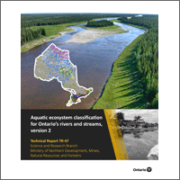Aquatic Ecosystem Classification for Ontario’s Rivers and Streams, Version 2
The Aquatic Ecosystem Classification (AEC) is a science-based tool used to classify Ontario’s rivers and streams based on their physical attributes (e.g., water temperature, turbidity, channel slope, upstream drainage area). The AEC reduces the complexity of these vast aquatic networks in Ontario by using consistent and quantitative methods to build a standardized data foundation that helps us understand and manage streams including landscape-scale planning and policy development. At the most basic level, we hope that people can derive expectations about the nature of a stream reach or segment without having to actually visit a stream.
The AEC has been in development for several years. Time was required to develop layers of information (e.g., water temperature predictions at the reach scale) that are needed to understand the variety of stream types in Ontario. This is not a simple or easy task given the estimated 500,000 km of streams across a land area of 1 million square kilometers. In the future we will provide additional layers of information such as climate change projections, human disturbance indices, flow regime type, and complete temperature predictions in the north. These are all helpful pieces of the puzzle towards understanding Ontario’s streams and rivers.
Many people have contributed to the development of the AEC especially Stephanie Melles, Isaac Sutton, Mike Parna, Sarah Parna, Kimisha Ghunowa, Paul Seelbach, Lizhu Wang, Dan McKenney and numerous students.
AEC and supplementary data can be found on GeoHub.
Jones, N.E. and B.J. Schmidt. 2022. Aquatic ecosystem classification for Ontario’s rivers and streams, version 2. Ontario Ministry of Northern Development, Mines, Natural Resources and Forestry, Science and Research Branch, Peterborough, ON. Science and Research Technical Report TR-47. 30 p. + appendices



